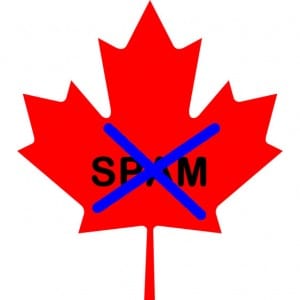(The thoughts and ideas included in this article are based on my own personal interpretation of CASL and are not intended to provide advice. Discussion is encouraged on these ideas.)
The Canadian Anti-Spam Legislation (CASL or Bill c-28) will come into force on July 1,  2014. This new law has wide ranging implications for anyone who sends emails (or any form of electronic messages) for commercial purposes.
2014. This new law has wide ranging implications for anyone who sends emails (or any form of electronic messages) for commercial purposes.
First of all this law applies to everyone and anyone in business these days. This legislation will not only affect email marketers or spammers. This law affects sales people, customer support, marketing or any individual sending a commercial electronic message (CEM).
The key to this whole legislation is about consent – did the person you are sending a message to electronically give you their consent? The ironic thing is that this law only deals with electronic messages, you can still phone anyone or send them as many postal messages as you like.
In comparison – the USA’s CanSpam law deals more with the Opt-Out provisions. Canada took the hard line around the Opt-In provisions.
Consent is divided up into two types; expressed consent and implied consent. Expressed consent means that you have a record of them stating that you can send them commercial electronic messages. Implied consent is a little more confusing. Implied consent has a number of categories such as clients, people who you have their business card, people who have listed their email on the internet, and even people who when this law came into force (July 1, 2014) you had already obtained consent previously. For more on consent see this informative article > http://www.zedpromarketing.com/js-ramblings/consent-mean-according-canadian-anti-spam-law/
There are a few exemptions to the stipulation that you need consent – but they are pretty slim. These include any individual you are currently in the midst of an on-going transaction, warranty information, and your mom (well your dad and siblings too – but not cousins!)
When obtaining expressed consent CASL describes in detail what needs to be communicated. Your information – or the information of whom ever you are obtaining consent for (if you are acting as an agent for a business or organization) and how to contact them. The type of commercial information you will be sending out. When an individual gives you consent – they must take an active part in the process (check a box, fill in email) as well this consent must not be tied to any other business arrangement.
Once you have consent and are sending CEM’s out you must include your postal address, who is sending them out as well as an unsubscribe mechanism. This is similar to the USA’s CanSpam legislation.
There are severe penalties for not abiding by this legislation. Individuals can be fined up to one million dollars and organizations can be fined up to ten million dollars. The Canadian government has already hired and is training enforcement officers to regulate this law.
Private right of action will be available to anyone who feels they have been harmed by a CEM sent without the proper consent starting in 2017. Liability could include the amount of loss (time, money, expenses incurred) as well as a violation fee up to $200 per item. This could be a substantial amount when looking at class action law suits against a host of violators.
The CASL will impact all business in Canada in some way. Higher cost of business due to tracking consent as well as tracking emails and other CEM’s. Informing and training staff at all levels. Due diligence when creating email campaigns. Take action now – before it comes into effect – to be sure you are ready when it is too late.
